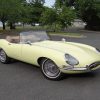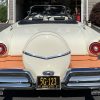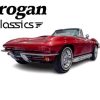1921
Description
This 1921 Hispano-Suiza H6B is one of approximately 2,360 H6-series examples built between 1919 and 1933. Chassis #10212 features five-passenger convertible coupe bodywork said to be by Kellner of Paris, France, and was refurbished in England before it was imported to the US in the early 1960s. It was purchased by the Indianapolis Motor Speedway Foundation out of Nyack, New York, in April 1963 and was displayed at Tony Hulman’s Early Wheels Museum in Terre Haute, Indiana, before being incorporated into the IMS Museum collection. The car is finished in dark green with black fenders over red leather upholstery, and power comes from a 6.6-liter monobloc inline-six paired with a three-speed manual transmission. Features include servo-assisted four-wheel drum brakes, a rear luggage rack, a bustle trunk, a black soft top, folding wood B-pillars, and dual side-mount spare tires. Service performed in preparation for the sale included the installation of replacement spark plug wires as well as a cleaning of the carburetor. Overhauls of the fuel and cooling systems are recommended by the seller prior to use. This Hispano-Suiza is now offered with tools, period photos taken in England, IMS Foundation purchase correspondence, and a clean Indiana title. Hispano-Suiza was founded in Barcelona, Spain, and the company’s early motorcars, including the H6, stemmed from designs of Swiss engineer and company co-founder Marc Birkigt. The company shifted its focus to aeronautical engineering at the outbreak of World War I, producing Birkigt-designed aluminum monobloc SOHC engines that were commonly used in period British and French military aircraft. Automotive production resumed in 1919 with the introduction of the H6, which was produced outside of Paris, France, and incorporated a number of mechanical features the company developed during the war. Previously finished in white with dark fenders, this example was painted in its current dark green with black fenders during its refurbishment in England. Features include a fold-down luggage rack, a central brake light, a bustle trunk, running boards, a Klaxon horn, cowl lamps, a stork hood ornament, and a polished radiator surround. The black convertible top features a glass rear window, and the wood top frame incorporates folding B-pillars. A New York State 1962-1963 inspection sticker is affixed to the windshield. Imperfections in the finish can be seen up close in the gallery below. The black wire wheels wear knock-off hubs and are mounted with Dunlop 7.00-21 bias-ply tires. Dual fender-mounted spare wheels are fitted with matching tires. The H6B rides on a 145″ wheelbase and features semi-elliptical leaf springs at all four corners. Four-wheel drum brakes are assisted by Hispano-Suiza’s patented “Servobrake” system that was introduced in 1919 and was standard on H6 models. The system utilizes a gear-driven hollow cross-shaft that connects to a 5″ brake drum spinning at 1/64th engine speed. The smaller drum is activated along with the four-wheel drums via the brake pedal to aid in stopping, resulting in pedal effort proportional to road speed. This system was later licensed to Rolls-Royce, who used it on models into the 1960s. The five-passenger, right-hand-drive cabin features red leather over the front and rear seats and door panels. A wood dash and door caps are fitted along with a glove box, a tilt-forward windshield, dual Bosch electric windshield wipers, and a dome light. The four-spoke steering wheel features hub-mounted controls and fronts an 80-mph speedometer, a 3,600-rpm tachometer, a Smiths clock, and auxiliary gauges. The five-digit odometer shows under 68k miles. Total mileage is unknown. The 6,597cc SOHC monobloc inline-six was developed from Hispano-Suiza’s aircraft engines and features aluminum alloy construction with steel cylinder liners, aluminum pistons, tubular connecting rods, two spark plugs per cylinder, and a crankshaft that was originally milled from a single 600-pound piece of billet steel. The engine was rated at 32 taxable horsepower when new. Replacement spark plug wires were installed in preparation for the sale by IMS Museum staff, who also cleaned the carburetor. Clogs found in the water pump and radiator can be seen in the gallery, and evidence of corrosion inside the radiator and prior leaks are noted by the seller, who recommends an overhaul of the cooling system prior to use. Engine stamping 300263 is shown above and is listed on the title as the VIN. Power is sent to the rear wheels via a three-speed manual transmission. Rust on the frame and exhaust system can be seen in the gallery below. An overhaul of the fuel system is recommended by the seller. A collection of photos taken in England can be seen in the gallery, along with documentation from the IMS Museum’s 1963 purchase. Located inside the famed 2.5-mile Indianapolis Motor Speedway oval, the IMS Museum is a nonprofit 501(c)(3) organization that relies on the support of visitors, members, donors, and corporate partners to make possible their daily operations, exhibits, restoration and preservation initiatives, and educational programming. To learn more about the IMS Museum and the many ways you can show support, including their “Adopt-a-Car” program, please click here.





































